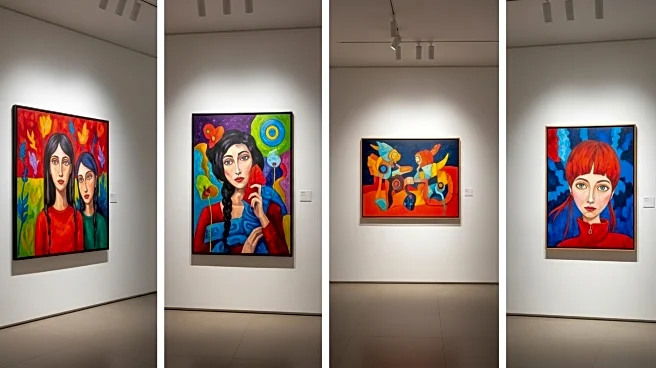What is the story about?
What's Happening?
Amy Sherald, renowned for her portrait of First Lady Michelle Obama, has relocated her retrospective exhibition, 'Amy Sherald: American Sublime,' from the Smithsonian Institution's National Portrait Gallery to the Baltimore Museum of Art. The move comes after Sherald pulled the exhibition due to concerns over potential censorship related to her painting 'Trans Forming Liberty,' which depicts the Statue of Liberty as a Black trans woman. Sherald feared the painting might not be displayed due to objections from the Trump Administration, which has criticized the Smithsonian for showcasing works deemed 'offensive.' The Smithsonian had proposed contextualizing the painting with a video discussing transgender issues, which Sherald opposed. The exhibition, featuring around 40 paintings, will open in Baltimore on November 2, 2025.
Why It's Important?
The relocation of Sherald's exhibition highlights ongoing tensions between artists and political entities over issues of censorship and representation. Sherald's decision underscores the challenges faced by artists in expressing themes of identity and social justice, particularly in politically charged environments. The move to Baltimore, a city significant to Sherald's artistic development, allows the exhibition to proceed without compromise, preserving the integrity of her work. This development may influence other artists and institutions in navigating similar controversies, potentially impacting public policy and cultural discourse around art and freedom of expression.
What's Next?
The exhibition will be on display at the Baltimore Museum of Art until April 5, 2026. It is expected to attract significant attention, given Sherald's prominence and the controversy surrounding its relocation. The museum's director, Asma Naeem, has expressed enthusiasm for hosting the exhibition, emphasizing Sherald's connection to Baltimore. The event may prompt discussions within the art community and among policymakers about the role of art in addressing social issues and the boundaries of artistic freedom. Stakeholders, including artists, museums, and political leaders, may engage in dialogue to address these challenges.
Beyond the Headlines
Sherald's retrospective not only showcases her artistic achievements but also serves as a platform for broader conversations about race, gender, and identity in contemporary art. The exhibition's move to Baltimore, a city with a rich cultural history, may foster deeper engagement with these themes among diverse audiences. Additionally, the situation raises ethical questions about the influence of political power on cultural institutions and the responsibilities of museums in supporting artists' voices. Long-term, this event could contribute to shifts in how art is curated and presented in politically sensitive contexts.
AI Generated Content
Do you find this article useful?
















